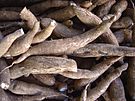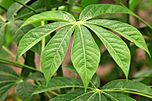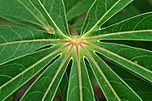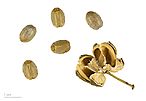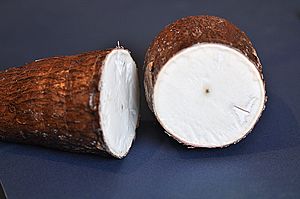Manioc facts for kids
Quick facts for kids Cassava |
|
|---|---|
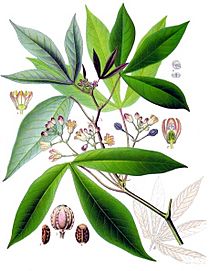 |
|
| Scientific classification | |
| Kingdom: | |
| Division: | |
| Class: | |
| Order: | |
| Family: | |
| Tribe: |
Manihoteae
|
| Genus: |
Manihot
|
| Species: |
M. esculenta
|
| Binomial name | |
| Manihot esculenta Crantz
|
|
Cassava (also called manioc or yuca) is a type of shrub. It grows in warm, tropical places. People grow cassava mainly for its edible (safe to eat) root. This root is very important for food around the world.
Cassava roots must be cooked correctly before you eat them. This helps remove any harmful substances. Once cooked, cassava can be used in many dishes. These include dumplings, soups, stews, and gravies.
Contents
What Does Cassava Look Like?
The cassava root is long and shaped like a cone. It has firm, white or yellowish flesh inside. The outside is a rough, brown skin about 1 millimeter thick. This skin can be easily peeled off.
Most cassava roots grown for food are about 5 to 10 centimeters wide at the top. They are usually 15 to 30 centimeters long. A woody part runs through the middle of the root.
Nutrients in Cassava
Cassava roots are full of starch, which gives you energy. They also have small amounts of calcium, phosphorus, and vitamin C. However, they do not have much protein or other important nutrients.
On the other hand, cassava leaves are a good source of protein. They have a lot of an amino acid called lysine. But they are low in another amino acid called methionine.
Where Did Cassava Come From?
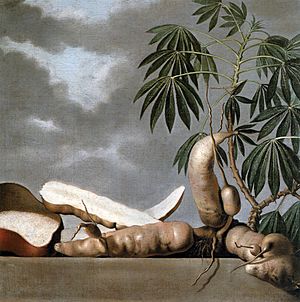
Cassava first grew in the wild in west-central Brazil. Scientists believe it was first grown by people there about 10,000 years ago. Early forms of today's cassava can still be found growing wild in southern Brazil.
By 4,600 BC, signs of cassava were found in Mexico. The oldest direct proof of cassava farming is from a 1,400-year-old Maya site in El Salvador.
Cassava in Ancient Cultures
Because it was such a good food source, cassava became a staple food (a main part of the diet) for people in South America, Central America, and the Caribbean. This was before Europeans arrived in 1492.
Ancient people often showed cassava in their art. For example, the Moche people often drew yuca on their pottery.
Cassava and European Explorers
When Spanish explorers first came to the Caribbean, they did not want to eat cassava or maize (corn). They thought these foods were not good enough. They preferred foods from Spain, like wheat bread, olive oil, and meat.
For these European Christians, cassava was not suitable for religious ceremonies. Wheat flour was seen as a symbol of Christianity. Old religious books said that only wheat flour could be used.
Cassava Spreads Around the World
Even so, people in both Portuguese and Spanish America kept growing and eating cassava. Making cassava bread became the first industry in Cuba started by the Spanish. Ships leaving Cuba needed large amounts of cassava bread for their long journeys.
Cassava was brought to Africa by Portuguese traders from Brazil in the 16th century. Around the same time, it also reached Asia through the Columbian Exchange. Portuguese and Spanish traders planted it in their colonies in places like Goa, Malacca, and the Philippines.
Today, cassava is a very important food in Africa and Asia. It has replaced many local crops. It is sometimes called the "bread of the tropics."
How Much Cassava Is Produced?
In 2016, the world produced 277 million tonnes of cassava root. Nigeria was the biggest producer, growing 21% of the world's total. Other major growers included Thailand, Brazil, and Indonesia.
| Cassava production – 2016 | |
|---|---|
| Country | Production (millions of tonnes) |
|
|
|
|
|
|
|
|
|
|
|
|
|
|
|
|
|
|
|
|
|
Where Does Cassava Grow Best?
Cassava is a very tough crop. It can grow well even when there is little rain. It also grows in poor soils where many other crops struggle.
Cassava thrives in areas near the equator, between 30° north and south. It can grow from sea level up to 2,000 meters high. It likes warm temperatures and can handle different amounts of rainfall. These conditions are common in parts of Africa and South America.
Cassava is also very good at producing a lot of food calories from a small area of land. It can produce more than 250 calories per hectare per day. This is much higher than rice (176), wheat (110), or maize (200).
Why Is Cassava Important?
Cassava, yams, and sweet potatoes are key food sources in tropical regions. Cassava gives the third-highest amount of carbohydrates per farmed area. Only sugarcane and sugar beets produce more.
Cassava is especially important in sub-Saharan Africa. This is because it grows well in poor soil and with little rain. It is also a perennial plant, meaning it can be harvested whenever needed. This flexibility helps farmers manage their work and provides food during difficult times.
Cassava's Role in Daily Life
Around the world, 800 million people rely on cassava as their main food. Africa depends on root crops like cassava more than any other continent. In many parts of tropical Africa, cassava is a primary or secondary staple food.
In Ghana, for example, cassava and yams are very important to the farming economy. They make up about 46% of the country's farm income. Cassava provides 30% of the daily calories for people in Ghana. Almost every farming family grows it. The importance of cassava to many Africans is shown in the Ewe name for the plant, agbeli. This name means "there is life."
Cassava is also widely grown and eaten in parts of India, like Tamil Nadu, Andhra Pradesh, Kerala, and Assam. In southern China, cassava is the fifth-largest crop. China is also a big buyer of cassava from Vietnam and Thailand.
How Is Cassava Used?
Drinks Made from Cassava
Many alcoholic beverages are made from cassava. These include cauim and tiquira from Brazil, kasiri from Guyana, and masato from Peru. These drinks show how versatile cassava is.
Cooking with Cassava
Dishes made from cassava are eaten widely wherever the plant grows. Some cassava dishes are very important to certain regions, countries, or cultures. Remember, cassava must be cooked properly to remove harmful substances before eating.
Cassava can be prepared in many ways. The root of the sweet variety has a mild taste and can be used like potatoes. It can also be ground into a flour. This flour is used to make breads, cakes, and cookies. In Brazil, detoxified cassava is ground and cooked into a dry, crunchy meal called farofa. This is used as a seasoning or eaten as a side dish.
Cassava for Fuel
Many countries are researching how to use cassava to make ethanol biofuel. China, for example, aims to produce a lot of ethanol fuel from plants like cassava.
In 2007, the largest cassava ethanol fuel factory was built in China. It produces 200,000 tons of ethanol each year. This needs about 1.5 million tons of cassava. Cassava chips have become a major source for making ethanol.
Cassava for Animal Feed
Cassava roots and hay are used around the world to feed animals. Cassava hay is cut when the plant is young, about three to four months old. It is then dried in the sun.
Cassava hay is rich in protein (20–27%). It is a good source of roughage for animals like cattle.
Cassava for Laundry
Cassava is also used in many laundry products. It is especially used as a starch for shirts and other clothes. If you dilute cassava starch in water and spray it on fabrics before ironing, it helps collars become stiff.
Images for kids
-
Taíno women preparing cassava bread in 1565: grating yuca roots into paste, shaping the bread, and cooking it on a fire-heated burén
See also
 In Spanish: Manihot esculenta para niños
In Spanish: Manihot esculenta para niños


